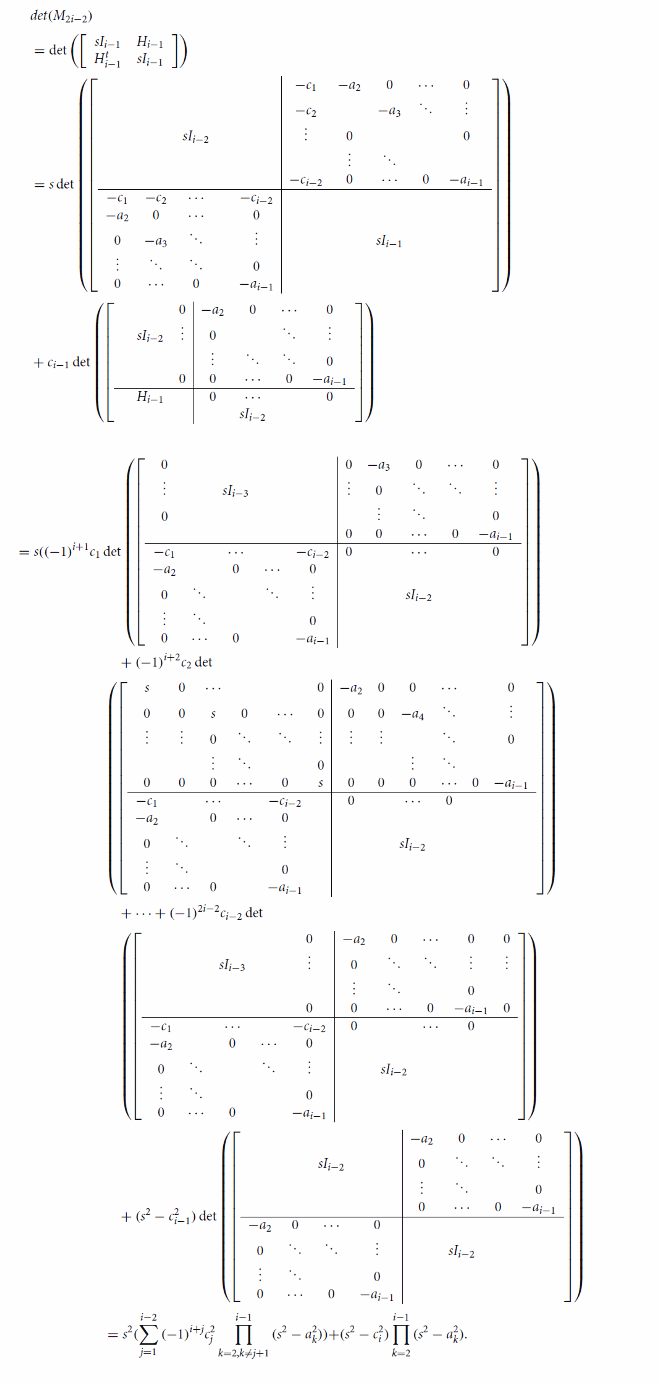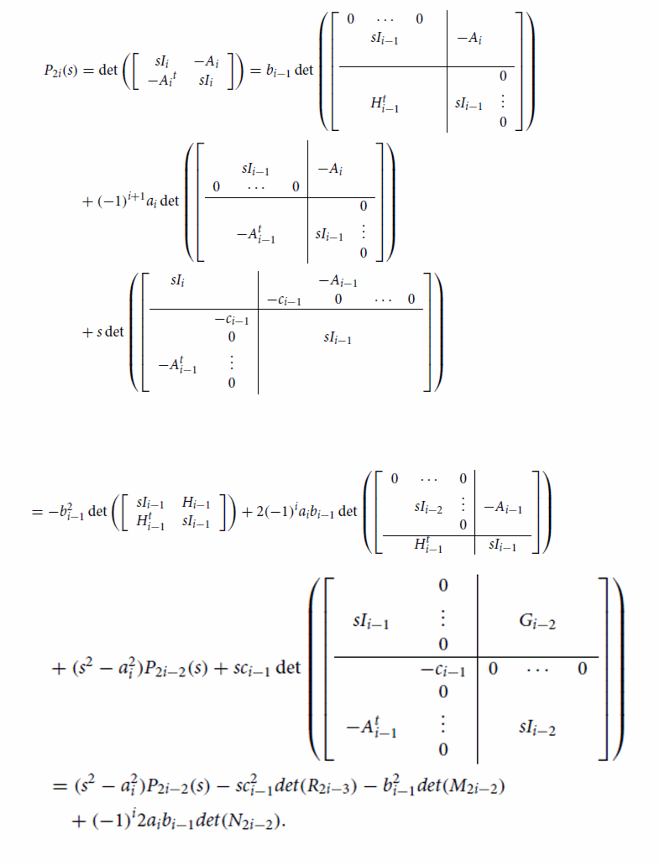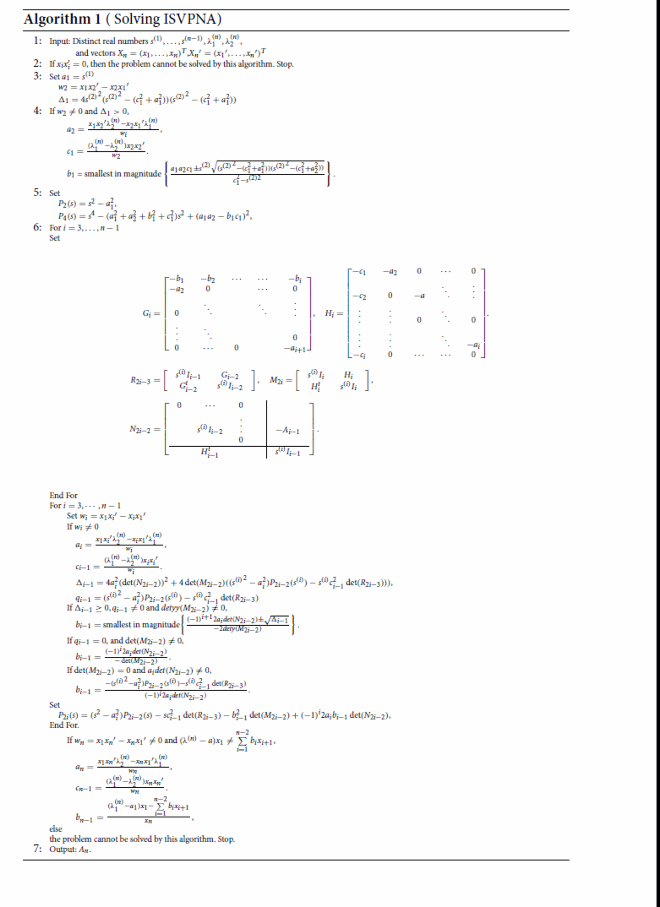 ?Mathematical formulae have been encoded as MathML and are displayed in this HTML version using MathJax in order to improve their display. Uncheck the box to turn MathJax off. This feature requires Javascript. Click on a formula to zoom.
?Mathematical formulae have been encoded as MathML and are displayed in this HTML version using MathJax in order to improve their display. Uncheck the box to turn MathJax off. This feature requires Javascript. Click on a formula to zoom.ABSTRACT
Constructing a matrix by its spectral information including singular values is called inverse singular value problem (ISVP). In this paper, an ISVP for nonsymmetric ahead arrow matrix by two eigenpairs of the required matrix and one singular value of each leading principal submatrices is investigated. To solve the problem, the recurrence relation of characteristic polynomial of the block Jordan–Weilant matrix associated with the aim matrix is obtained. The conditions of solvability of the problem are derived. Finally a numerical algorithm and an example are given.
1. Introduction
An inverse eigenvalue problem (IEP) is the problem of generating a matrix using its total or partial spectral information. In some practical applications, the system in hand is modelled as a matrix. The spectral information of such matrices will contain some intrinsic properties of the system, hence by applying the desired conditions on the matrix entries and its spectral information, we will be able to generate a matrix that represents a system with the desired properties. There are many different types of IEPs. Chu and Golub in [Citation1] presented an elaborate classification of IEPs. Some IEPs include singular values information, which are called inverse singular value problems (ISVPs). IEPs have been considered by many researchers because of their applications in various sciences. Control issues [Citation2], finite element [Citation3,Citation4], mechanic [Citation5] and perturbation [Citation6] are examples of practical applications of IEPs in mathematics and engineering. The level of difficulty of an IEP depends on the available eigen information and the structure of the matrix to be constructed. Graph theory is another practical field in which the IEP of matrices corresponding to a graph is studied. It has been of interest for many years and been studied in many works [Citation7–18].
An ahead arrow matrix , defined as follows:
(1)
(1) such that the diagonal entries are real and
. The IEPs of the graph corresponding to this matrix are studied by O. Boyko in [Citation19] and J. Eckhardt in [Citation20] in order to solve an inverse spectral problem for a star graph of Stieltjes strings and Krein strings, respectively. In 2006, Peng in [Citation21] studied an application of the ahead arrow matrix
in control theory and showed that it is equivalent to an IEP of it. Pickman et al. in [Citation22] in 2007 studied an IEP of this matrix by the minimal and maximal eigenvalues of its all leading principal submatrices. After that Sharma et al. in [Citation15,Citation16] and Xu et al. in [Citation17] also investigated recursive construction of the symmetric case of this matrix with different eigen information of the submatrices of the required matrix. Recently, Pickmann et al. in [Citation23] studied an IEP, and some spectral properties, of this matrix in the nonsymmetric case.
In this paper, we solve the ISVP stated below, denoted by ISVPNAFootnote1, consisting in constructing a matrix of form with partial eigendata and singular value information.
Problem 1.1
ISVPNA
n + 1 real distinct numbers , two vectors
and
,
, are given. Find matrix
such that
is singular value of leading principal submatrices
,
and
are two eigenpairs of
.
The paper is organized as follows. In Section 2, we introduce the problem statement and some of the preliminary concepts that will be used throughout the paper. In Section 3, main results are discussed and an algorithm is given. In Section 4, we present an example to illustrate the efficiency of the proposed method, and finally, in Section 5 is some concluding remarks and future perspectives.
2. Preliminaries
Every matrix A can be decomposed into
where
and
are orthogonal and Σ is a
diagonal matrix [Citation24]. This decomposition is called the singular value decomposition (SVD).
We define the Jordan–Weilant matrix as
(2)
(2)
to denote the
leading principal submatrix of
.The matrix
is symmetric and hence all of its eigenvalues are real. The singular values of
are absolute value of eigenvalues of
[Citation24]. Throughout the paper let
(3)
(3)
(4)
(4) In the next section, the main results and numerical algorithm of the solution are given.
3. Main idea
In this section, we will present necessary proofs to obtain the solution of ISVPNA.
Lemma 3.1
If s is a scalar and
(5)
(5)
(6)
(6)
(7)
(7) for
then
Proof.
It is achieved by expanding the determinant. To compute we have

and
can be obtained by similar way.
In the following Lemma, the recurrence relations of characteristic polynomial of are given.
Lemma 3.2
The sequence of characteristic polynomials of
satisfies the following recurrence relations:
(8)
(8)
Proof.
and
are clearly obtained by expanding the determinant. For
, we have

and the proof is completed.
In the following Lemma, we show that every component of
is a multiple of
.
Lemma 3.3
If and
is an eigenpair of
, then
and the entries of
are obtained as:
(9)
(9)
Proof.
Since is an eigenpair of
, so
. By expanding this relation one obtains:
(10)
(10)
(11)
(11) therefore
(12)
(12) We note that the denominator is nonzero, because if not, from Equation (Equation11
(11)
(11) )
, hence it follows
which contradicts the conditions of matrix
. Since
is an eigenvector, hence
, if
then from Equation (Equation12
(12)
(12) ) all the other entries of
become zero. Thus
and the proof is completed.
3.1. The solution of ISVPNA
Now, we will present the conditions under which there is solution to ISVPNA. Let
and
Theorem 3.4
If
,
,
,
,
then ISVPNA has solution.
Proof.
Let the conditions 1–4 hold. It is easy to see that . We set
. Since
and
are two eigenpairs of
, so by Lemma (3.3) for
(13)
(13)
From condition 1, is nonzero, therefore
(14)
(14)
(15)
(15) Now to obtain
, we use the Jordan-Weilant matrix
. The singular values of
are equal to the absolute value of eigenvalues of
, therefore,
. In matrix
:
by rewriting this equation, we get
as
(16)
(16) From condition 2,
and so these two solutions are real. Without loss of generality, we take the one with smallest magnitude as
. This issue is also evident in higher dimensions of the matrix. From Lemma (3.2),
is a quadratic equation in
, by rewriting this equation and substituting
in
and
for
, we obtain
(17)
(17) From condition 2,
is nonnegative, so
By similar way, we take the one with smallest magnitude as
.
Depending on which of the following conditions is met, we set the as follows:
If
, we get
If
, we set
From condition 3, Equation (Equation17(17)
(17) ) does not have double zero roots, therefore in all of mentioned cases we get nonzero
.
Finally, from Equation (Equation11(11)
(11) ), we get
from condition 4,
is nonzero. So it completes the proof.
Remark 3.1
By selecting another root of or
this problem will have at most
solutions.
The resulting algorithm takes the form of Algorithm 1.

4. Numerical experiments
In this section, we present the numerical results of ISVPNA. The computational results are provided by MATLAB software.
Example 4.1
In graph theory, the energy of a graph with n vertexes is defined by . By obtaining any principal submatrices of
, we can get energy of graph with adjacency matrix
. Let
and vectors
By applying Algorithm 1, we get
Table weights of graph G with adjacency matrix
, eigenvalues
, energy of graph
and
to compare with data of this problem are presented. The corresponding eigenvectors of
and
are as follows:
Table 1. Results of graph G by ISVPNA.
5. Conclusion
In this paper, an ISVP called ISVPNA, for ahead arrow matrices is studied. We constructed the matrix by one singular value from each of the leading principal submatrices and two eigenpairs of the required matrix. For this purpose, we have used Jordan–Willant matrix and the relation between singular values of and eigenvalues of
. Given that the dimensions of
are always even, the recursive relationships are organized based on the reduction of two indices in each iteration. Also by using different blocking, characteristic polynomial of
is obtained as a second-order polynomial in
. The conditions under which the ISVPNA will have solution are obtained and we showed that it is possible to have at most
solutions to ISVPNA. To the best of our knowledge, this is the first work that studied recursive construction of matrices by singular values. As a future work, it would be interesting to study the application of ISVPNA to perturbation problems related to the
in control theory.
Disclosure statement
No potential conflict of interest was reported by the author(s).
Notes
1 Inverse Singular Value Problem for Nonsymmetric Ahead arrow matrix.
References
- Chu Moody T, Golub Gene H. Inverse eigenvalue problems: theory, algorithms, and applications. Vol. 406. New York (NY): Oxford University Press; 2005.
- Williams DE, Johnson DH. Robust estimation on structured covariance matrices. IEEE Trans Signal Process. 1993;41(25):2891–2906.
- Gladwell GM. Inverse vibration problems for finite-element models. Inverse Probl. 1997;13(2):311–322.
- Ying W, Dai H. An inverse eigenvalue problem for the finite element model of a vibrating rod. J Comput Appl Math. 2016;300:172–182.
- Starek L, Inman DJ. Symmetric inverse eigenvalue vibration problem and its application. Mech Syst Signal Process. 2001;15(1):11–29.
- Qifang S. Inverse spectral problem for pseudo-Jacobi matrices with partial spectral data. J Comput Appl Math. 2016;297:1–12.
- Brown BM, Eastham MSP, Wood IG. Estimates for the lowest eigenvalue of a star graph. J Math Anal Appl. 2009;354(1):24–30.
- Dela Pena JA, Rada J. On the multiplicity of the eigenvalues of graph. Acta Math Hungar. 2007;114(1-2):91–101.
- Heydari M, Shahzadeh Fazeli SA, Karbassi SM. On the inverse eigenvalue problem for a special kind of acyclic matrices. Appl Math. 2019;64(3):351–366.
- Heydari M, Shahzadeh Fazeli SA, Karbassi SM, et al. On the inverse eigenvalue problem for periodic Jacobi matrices. Inverse Probl Sci Eng. 2019;28(9):1253–1264.
- Babaei M, Shahzadeh Fazeli SA, Karbassi SM. Inverse eigenvalue problem for constructing a kind of acyclic matrices with two eigenpairs. Appl Math. 2020;65:89–103.
- Leal-Duarte A, Johnson CR. On the minimum number of distinct eigenvalues for a symmetric matrix whose graph is a given tree. Math Inequalities Appl. 2002;5(2):175–180.
- Monfared KH, Shader BL. Construction of matrices with a given graph and prescribed interlaced spectral data. Linear Algebra Appl. 2013;438(11):4348–4358.
- Sen M, Sharma D. Generalized inverse eigenvalue problem for matrices whose graph is a path. Linear Algebra Appl. 2014;446:224–236.
- Sharma D, Sen M. Inverse eigenvalue problems for two special acyclic matrices. Mathematics. 2016;4(1):12.
- Sharma D, Sen M. Inverse eigenvalue problems for acyclic matrices whose graph is a dense centipede. Linear Algebra Appl. 2018;6(1)
- Xu WR, Chen GL. On inverse eigenvalue problems for two kinds of special banded matrices. Filomat. 2017;31(2):371–385.
- Fernandesa R, Fonsecab CM. The inverse eigenvalue problem for Hermitian matrices whose graphs are cycles. Linear Multilinear Algebra. 2007;57(7):673–682.
- Inverse spectral problem for star graph of Stieltjes strings. Methods of Functional Analysis and Topology. 2008;14(2):159–167.
- Eckhardt J. An inverse spectral problem for a star graph of Krein strings. Institut Mittag-Leffler, Auravoagen. 2014;2016(715).
- Peng J, Hu Xi-Yan, Zhang L. Two inverse eigenvalue problems for a special kind of matrices. Linear Algebra Appl. 2006;416(2):336–347.
- Pickmann H, Egaa J, Soto RL. Extremal inverse eigenvalue problem for bordered diagonal matrices. Linear Algebra Appl. 2007;427:256–271.
- Pickmann H, Arela S, Egana J, et al. On the inverse eigenproblem for symmetric and nonsymmetric arrowhead matrices. Proyecciones J Math. 2019;38(4):811–828.
- Datta BN. Numerical linear algebra and applications. New York (NY): Brooks/Cole Publishing Company; 1995.
